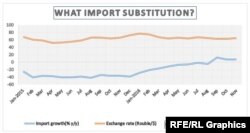In the fall of 2014 shortly after Western sanctions were slapped on Russia for its actions in Ukraine, and Moscow responded with its own countersanctions, import substitution was a hot topic at the Kremlin. The subject didn’t have quite the buzz a year later, and by 2016 few if any Russian officials were talking about import substitution. And here’s why.
Even with the sharp devaluation of the ruble during the current crisis the share of Russian industrial imports has not dropped although overall Russian imports are down between 30 and 40 percent (See graph). From January 2014 to September 2016 as the ruble lost a quarter of its value compared to the U.S. dollar, the share of Russian industrial imports as a share of overall Russian imports remained unchanged at about 40 percent, according to research from the Gaidar Institute for Economic Policy.
However, during his annual year-end press conference on December 23, President Vladimir Putin stated that Russian industrial imports had contracted by 10 percentage points from 49 percent to 39 percent although he did not site over what time period. The Russian leader also failed to mention the steep drop in Russian industrial output over the past two years, which against the background of the devaluation of the ruble led to a reduction in the total volume of imports by industry. According to data from the Russian state statistics service Rosstat, Russian industrial output dropped by 3.4 percent in 2015 after a growing by 1.7 percent in 2014. Over the first 11 months of 2016, overall Russian industrial output was up a measly 0.8 percent and this due to a boost from the country’s mining industry. Over the same time period, Russia’s manufacturing sector continued to contract – by 0.3 percent in comparison to the same January-November period in 2015.
Moreover, in 2016 as the ruble strengthened, the share of imports in many sectors of industry began to grow again. According to analysis from the Gaidar Institute, industrial equipment imports rose from 27 percent at the start of 2014 to 41 percent in October 2016; household appliance imports rose from 41 percent to 43 percent during the same time period; pharmaceutical and medical products from 53 percent to 60 percent.
At the start of 2016 a stronger ruble led to rising imports overall in Russia. (See graph) Although just a year earlier, imports were down between 30 and 40 percent over the same period in 2014.
It’s worth noting, that certain sectors of the Russian economy are faring better than others during the current crisis. For example, the chemical industry, which the government is fond of highlighting as a “success” of import substitution. But fertilizers account for more than half of the chemical industry’s output. And only about 30 percent of Russian fertilizers are used inside Russia, with the rest shipped out as exports, notes the director of the research institute, Development Center, Natalya Akindinova. And a weaker ruble has made Russian fertilizers even more competitive on world markets.
Another example is the food processing industry, where import substitution was “secured” due to Moscow’s food import ban. (Russia banned wholesale imports of fresh food products from many Western countries in 2014 in retaliation for sanctions over its annexation of Crimea and support for separatists in eastern Ukraine.) However, in many cases, much of what Russia’s domestic food processing industry has churned out – especially in the production of cheese, butter, and sausages – does not meet industry standards. That assessment is not only being voiced by independent industry experts, but official commissions responsible for overseeing the consumer market.
Moreover, the volume of import substitution in Russia’s food processing industry, noticeably increasing after the imposition of Russian countersanctions in 2014, began to slide already at the end of 2015, noted experts at the Gaidar Institute, studying the process of import substitution in the Russian economy.
All in all, Russia’s food processing industry became discouraged with the country’s agricultural sector, the Gaidar Institute experts concluded. In particular, the industry became disillusioned not only with the quality of agricultural commodities, but with the unpredictability in their delivery. As a result, the industry began again to seek out foreign agricultural providers.
In general, import substitution turned out paradoxically to be completely irrelevant to Russian industry, according to the Gaidar Institute. And the reason, in their words, is simple – the absence in Russia of the type and quality of goods produced abroad.






